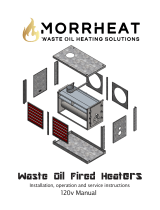
153B0801
6
O4MD-140A-16-F Model:
1. Rotate the furnace 90° to the desired position.
2. Remove the three nut and washer sets fastening the
oil burner assembly to the furnace. Rotate the oil
burner assembly to be in the upright position.
(Ignition transformer and primary control relay control
should be on top).
3. Re-align the oil burner assembly to the combustion
chamber (fire-pot), then secure into place with the
three nut and washer sets.
4. Remove the cover from the flue collar.
5. Remove the screws securing the flue collar to the
furnace, then rotate the flue collar 90°, such that the
venting attaches to the top.
6. Secure the flue collar to the furnace, then reinstall the
flue collar cover.
NON-SUSPENDED INSTALLATION
Maintain clearances to combustibles as outlined in Table
1. Installation on a combustible floor requires a clearance
of 1 inch. This can be done by using noncombustible
materials such as one inch thick channel iron or similar
material. The furnace must be supported in such a way
as to not allow twisting or sagging of the cabinet.
Suggestion; as a measure to prevent fuel oil from
accumulating in locations other than the fire pot, as could
be the case in the event of nozzle drip, install the furnace
with an approximate 2 degree slope from the oil burner
casing towards the fire pot. Use shims made of
noncombustible material.
SUSPENDED INSTALLATION
O4MD-091A-12-F: Maintain clearances to combustibles
as outlined in Table 1. The recommended method to
suspend the furnace is to fabricate a cradle with angle
iron, 2” slotted angle, or steel channel and 3/8” threaded
rod. The threaded rod should be located external to the
furnace. The furnace must be supported in such a way as
to not allow twisting or sagging of the cabinet. Position
the cradle so as to not interfere with accessing the burner
and blower compartments. Suggestion; as a measure to
prevent fuel oil from accumulating in locations other than
the fire pot, as could be the case in the event of nozzle
drip, install the furnace with an approximate 2 degree
slope from the oil burner casing towards the fire pot.
O4MD-140A-16-F: Maintain clearances to combustibles
as outlined in Table 1. Remove the four circular knock-
outs on the top panel, and similarly, the four circular
knock-outs on the bottom panel. The removed knock-
outs allow 3/8 inch treaded road to be inserted through
the interior of the furnace. Use care when inserting rods,
since the foil backed insulation can be easily ripped and
torn away from the panel surfaces. Secure the furnace
with 2 inch minimum slotted angle or equivalent, as
shown in Figure 4, page 15. The furnace must be
supported in such a way as to not allow twisting or
sagging of the cabinet. Suggestion; as a measure to
prevent fuel oil from accumulating in locations other than
the fire pot, as could be the case in the event of nozzle
drip, install the furnace with an approximate 2 degree
slope from the oil burner casing towards the fire pot.
4. AIR CONDITIONING APPLICATIONS
If the furnace is used in conjunction with air conditioning,
the furnace shall be installed in parallel with or upstream
from the evaporator coil to avoid condensation in the heat
exchanger. In a parallel installation, the dampers or air
controlling means must prevent chilled air from entering
the furnace. If the dampers are manually operated, there
must be a means of control to prevent the operation of
either system unless the dampers are in the full heat or
full cool position. The air heated by the furnace shall not
pass through a refrigeration unit unless the unit is
specifically approved for such service.
IMPORTANT: DO NOT INSTALL AN AIR
CONDITIONING EVAPORATOR COIL IN THE RETURN
AIR PLENUM.
The blower speed must be checked and adjusted to
compensate for the pressure drop caused by the
evaporator coil. Refer to Appendix B for recommended
wiring and electrical connections of the air conditioning
controls.
5. COMBUSTION AIR
If the furnace is installed in a closet or utility room, two
openings must be provided connecting to a well-
ventilated space (full basement, living room or other room
opening thereto, but not a bedroom or bathroom). One
opening shall be located above the level of the upper vent
opening and one opening below the combustion air inlet
opening in the front of the furnace. Each opening shall
have a minimum free area of 1½ square inches per 1,000
Btu/h of total input rating of all appliances installed in the
room.
For furnaces located in buildings of unusually tight
construction, such as those with high quality weather
stripping, caulking, windows and doors, or storm sashed
windows, or where basement windows are well sealed, a
permanent opening communicating with a well ventilated
attic or with the outdoors shall be provided, using a duct if
necessary. The duct opening shall have a free area of 1½
square inches per 1,000 Btu/h of total input rating of all
appliances to be installed. When a furnace is installed in
a full basement, infiltration is normally adequate to
provide air for combustion and draft operation. Furnace
rooms under 700 ft³ (65m³) should automatically be
treated as confined space.




















